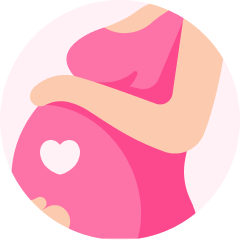Holding your child for the first time after you give birth to them can be an emotional experience. You promise to take care of them and let no harm come to them; however, that doesn’t mean you should overlook your health. Remember, every mother needs to recover after giving birth. Here are some postpartum care recovery tips to help you take care of yourself after you get a C-section.

Postpartum Care – Recovery Tips: Don’t Push Yourself
Once you give birth to your baby, you may be eager to be there for your child at all times. While a new baby can be demanding, you should learn how to take a break, especially after a C-section.
-
Make recovery a priority.
Many women stay in the hospital for about 2-4 days when they recover from a C-section. You can use that time to bond with your baby and give your body a break.
-
Sleep when the baby sleeps.
You may hear people tell you that you should sleep whenever your baby sleeps. That is good advice to take since it gives you the chance to rest as much as possible, especially since your infant will be resting a lot of the time, too.

-
Avoid rigorous activity.
You should not attempt to do anything strenuous, especially when you still feel pain or soreness. Ideally, you should avoid carrying anything heavier than your baby until you recover.
While you may be itching to get around and move, it is crucial in postpartum care to remember that you had surgery. It normally takes 6-8 weeks to recover. You should avoid rigorous activity, such as core muscle exercises until a doctor says it is okay.
Postpartum Care – Recovery Tips: Dealing with Blood Clots, Infection, and Cramps
Women often deal with blood clots and bleeding after giving birth. However, you ought to speak to a doctor if there are worrisome symptoms such as unusually heavy bleeding and large blood clots.
-
Blood Clots
Another thing women ought to be aware of is dealing with blood clots in the veins. Women have a higher risk of getting blood clots 12 weeks after giving birth.
However, getting a blood clot or potentially deep vein thrombosis after birth is more likely to occur when a person has not moved for long periods or is overweight. It would be helpful to get up, if possible, and walk around to prevent blood clots as part of your postpartum care. If a woman cannot move, there are often special cuffs that they can put on their legs to encourage the blood to move.

-
Bleeding
While you are at the hospital, a doctor or a nurse will monitor your cesarean incision carefully to look for symptoms of infection while checking for vaginal bleeding. Bleeding can last for 4-6 weeks after giving birth and will be heavier during the first several days.
-
Cramps
It is normal to feel some pain at the side of your incision during the initial 24 hours. As their uterus shrinks, some women may feel post-birth cramps. The cramps often feel like more intense menstrual cramps.
Postpartum Care – Recovery Tips: Taking Care of the Scar
The wound from your C-section may feel sore for about 1-2 weeks. You may also feel weakness in the muscle that surrounds the wound. It would be best to ask a doctor about pain medication while nursing to avoid harming your baby’s health.
Kinds of C-Section Incisions
There are 2 kinds of incisions that you can get for your C-section. The first one is a horizontal incision, the Pfannenstiel incision, which is also called a bikini cut, that is used for most cesareans. The cut is done on the lowest uterus part, which can help lessen bleeding.
The vertical incision is also called a classical C-section. Back in the day, it was more common than the bikini cut, however, it is now used for more specific cases. These types of incisions can take a bit longer to heal and may feel a bit more painful.
Typically a doctor will use dissolvable stitches. However, a doctor might use non-dissolvable stitches which will have to be taken out several weeks after you give birth. There are also other ways a doctor can close the incision, such as glue or staples.

Cesarean Scars
Oftentimes a scar from a cesarean can heal properly. However, you may have issues with scarring when your body goes into overdrive with the healing process during your postpartum care. This is more likely to happen if you have dark skin or are younger than 30 years old.
The first kind of scar you can get is a keloid scar. This happens when the scar tissue goes beyond the wound’s original boundaries. This can create scar tissue lumps around your incision.
The second kind of scar that you can get is a hypertrophic scar. Compared to a normal scar, it is raised, firmer, and thicker but it will stay within the incision line.
Wound Care
When you shower — preferably once a day or as directed by your doctor — keep your wound clean by allowing soapy water to drip towards your wound without vigorously scrubbing it. You can pat dry the area gently using a clean towel when you are done.
To speed up your healing process, it is best to avoid tight-fitting clothing because it can irritate the incision. You can opt for loose-fitting clothes such as pyjamas, jogging pants, baggy shirts, etc.
You should also avoid exercising because it can reopen your incision. Avoid lifting heavy objects and bending over because these movements can also reopen your incision.
Some doctors will tell you to leave your wound uncovered and allow it to heal naturally. However, other doctors will say that you can apply petroleum jelly or a topical ointment and use a bandage to lightly cover the wound. It would be best to ask your doctor what the best method would be to deal with your scar during postpartum care.
You are precious mommies!
[embed-health-tool-bmi]


















